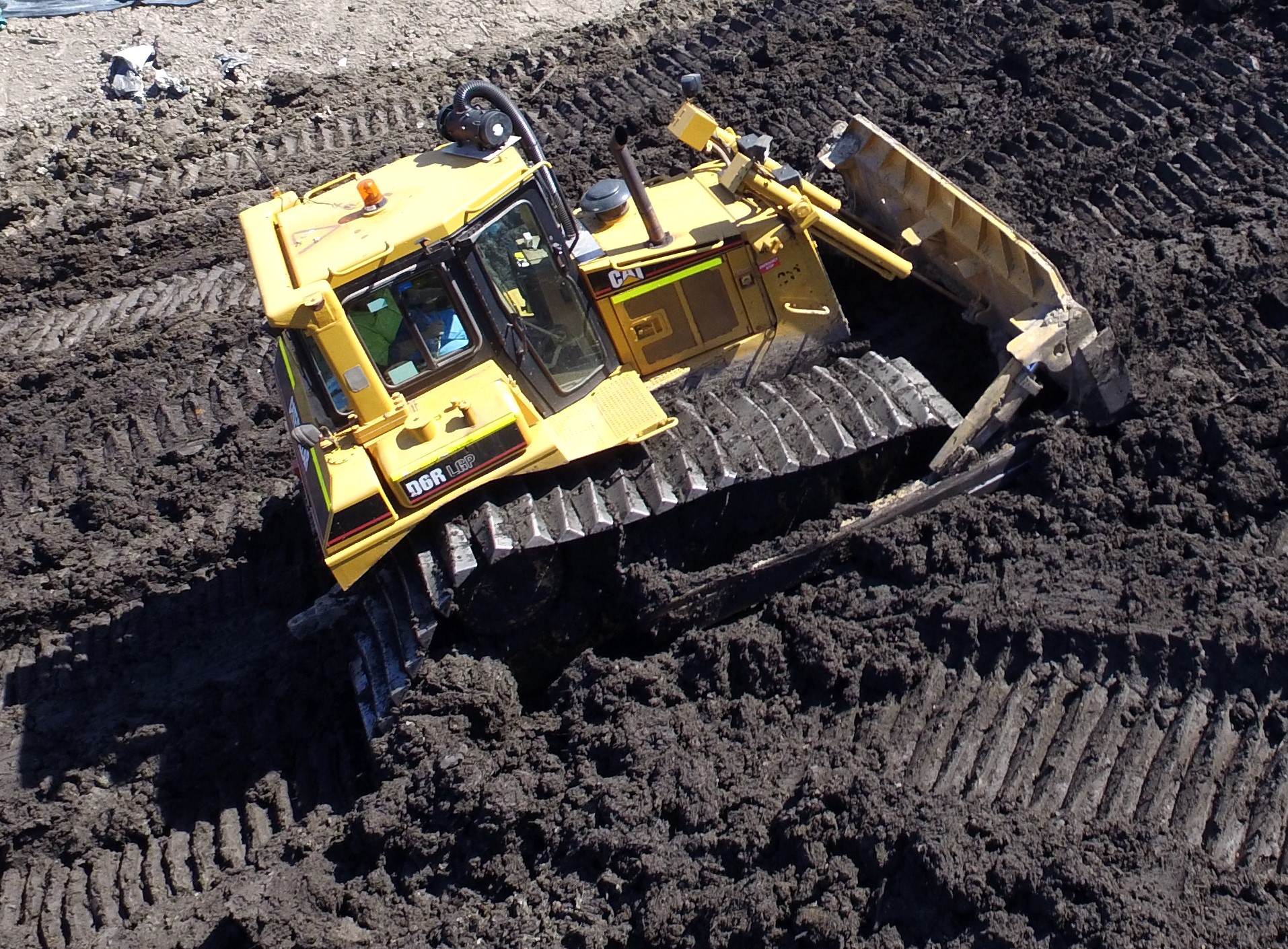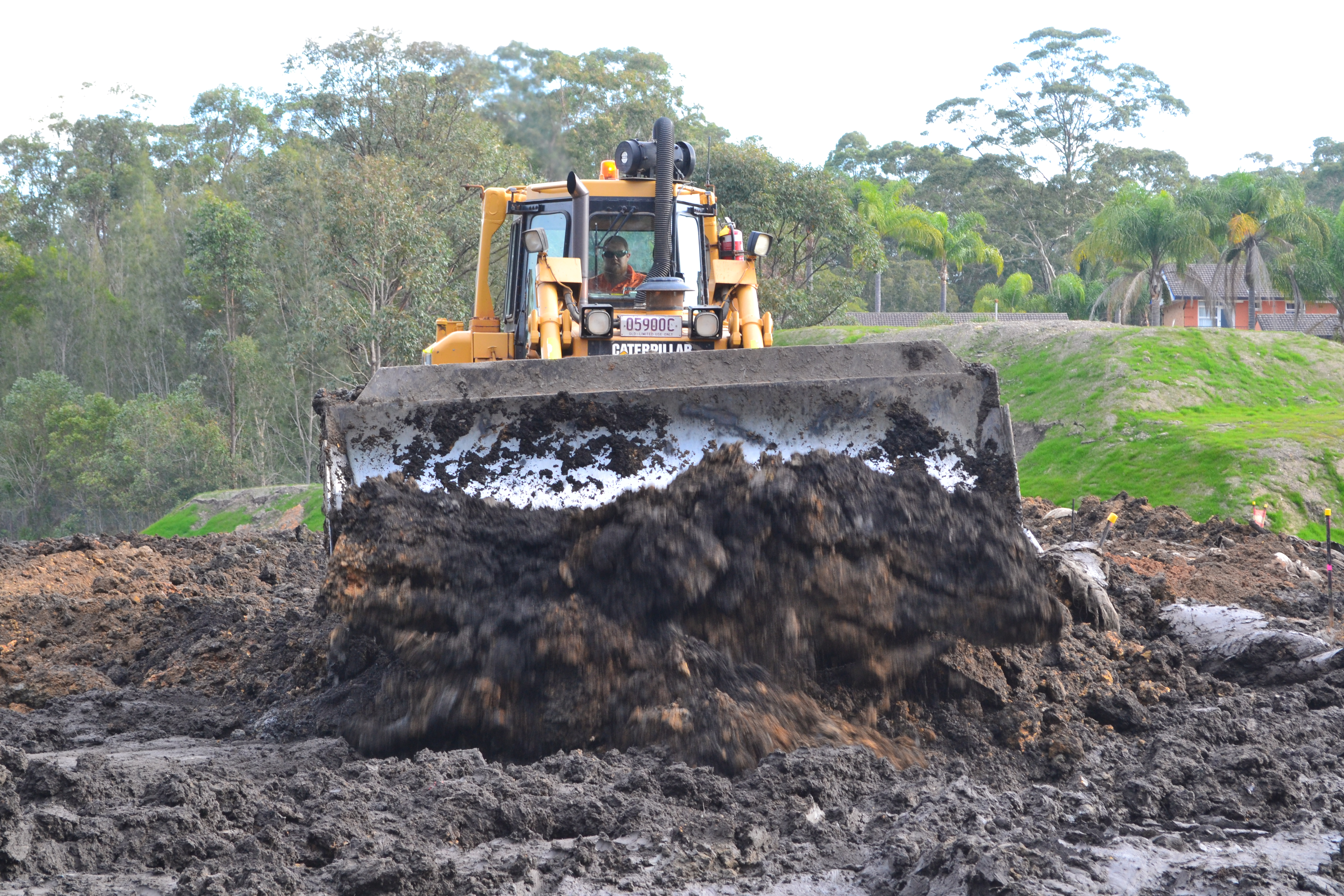When RON HORNER saw a Cat D6R LGP swamp dozer at work on a muddy, toxic mine remediation site, he couldn’t resist taking it for a test run.
Specific projects require specific plant and equipment, and when that time comes around (for those who are patient and astute enough to have the gear available), that time becomes ‘payday’.
CAT D6R LGP SWAMP DOZER
I came across a project on the mid-north coast of NSW where this was exactly the case, and a lateral approach to a difficult project required not only a project manager with the knowledge and people-handling skills to successfully complete the tasks, but to look outside the proverbial box and source the best and most suitable equipment required for a timely and safe execution of the construction – or, in this case, the difficult remediation of a toxic mine site.
One such item of equipment to play an integral part of the execution of those difficult day-to-day tasks was the Caterpillar D6R LGP swamp dozer, bought in for part of the many difficult phases of the Antimony Mine Site remediation project undertaken by the Soil Conservation Service of NSW for the Department of Trade (Lands).
Project manager Clayton Colmer and site superintendent Jason Bashforth allowed us unimpeded access to the project to further our quest to deliver our readers and viewers some of the more interesting and challenging aspects undertaken in the construction and mining industry .. and this is one hell of a challenging project.
Subtinite (antimony) was a mineral mined upstream of Urunga and hauled to the site in between the Pacific Highway and the lovely Coffs Coast on the mid-north coast of NSW. Processing this mineral produced arsenic, mercury and other nasty metals which, as was in those wild west days in the 60s and 70s, leached into the pristine wetlands without any thought of ongoing environmental issues that would haunt (not only this site but numerous others all over Australia) generations to come.
Treatment of the toxic material on-site meant that a clayey and multi-lined geofabric and plastic-layered mono-cell would be constructed to house the 30,000 cubic metres of toxic mud waste anticipated to be excavated from the contaminated wetlands. This would be eventually covered in several layers of plastic and reinforced geofabric, multiple layers of crushed compacted rock, and almost a metre of clayey and topsoil.
Winning of this material and haulage are one thing but spreading the “slosh” and attempting to keep open the haulage access into the pit is another … this is where the “Swampy” took control.
 |
|
Like a pig in … um … mud
|
IN THE CAB
This particular machine is an Asian import with 7000+ hours on the metre and, although a tidy machine, gives me the pips that the bloody cab instructions are still in Chinese … ahh!
If you, as a contractor, are importing an Asian machine, please get the signage updated to English … I think you have a legal obligation here, and I would not like to be on the end of a coronial enquiry should something go awry from an accident or incident relating to this. The cabin was pretty clean as the machine entered the site, but it didn’t last too long due to the fact that the unforgiving mud eventually takes over everything you touch – ‘cabin cleanouts’ were common place on this site, not only on the swampy, but in all the gear.
Noise levels are well within the industry standard, pushing out under 80dB(A) inside the cabin, so the radio and air-conditioning are easily heard and felt during operation. One thing I did find whilst in the cabin was that you could actually hear the transmission and any oddball noises that could creep into the machine – no rocks or clang, clang, clanging over rough ground here, just the whirr of the slush oozing through the tracks.
As with all Cat gear, the dashboard layout is pretty good. All the relevant gauges are there and in easy-to-read positions; a decelerator pedal is a must for final trim control in some aspects, and is located in the normal position to the right side of the dash.
Air-conditioning, two-way radio, flashing lights, AM/FM Radio and a HEPA filter fitted to the machine complete the unit. The HEPA filter is a WHS and EPA requirement due to the fact of the toxic nature of the material being excavated on this site. This filter pressurises the cabin, has the capability to deliver filtered air through the air-conditioner, and ensures the cabin cannot take on board any external nasties that could be floating in the air. All the men who have worked on site have to undergo a stringent medical both before and after completion of their on-site duties in an effort to monitor the ‘before and after’ health conditions of each person.
ON THE JOB
When I got to see my first swampy muscled up with the big wide track plates, I thought it looked like a dozer on steroids.
On each side of the D6 are a series of wide apex or triangular-shaped track plates sitting at 915mm in width (almost 400mm wider than conventional), which are designed to work in soft or wet conditions. The wide track shoes, long track frames and wider machine gauge increases ground contact and reduces ground pressure for improved stability, requiring flotation in swampy conditions – and believe me, it needed every one of those attributes on this job.
The ground clearance on this rig is 450mm, so it doesn’t take long to shorten that up when you are in the mud – you can guarantee the belly plates will cop a workout big time, so gently does it during your pushing operations. The machine width sits at a perfect 3140mm, inside the 3.5m legal over-width limit, 5.5m in total length with a blade fitted (not rippers), and weighs in at a hefty all-up weight of about 28 tonne.
When you think about it, that sure is some weight to throw around on a mud heap not capable of carrying a person on foot or anything conventional tracked, but the design of the swampy track plates ensure the 5.15psi or .362kg/cm2 distributes the weight accordingly.
From recollection, I think a human exerts about 7.0psi unless you are in high heels – I haven’t been caught wearing my high heels to site for quite a while now, so I could be wrong!
This machine “WILL NOT FLOAT”, so don’t get your ambitions mixed up with the machine’s capabilities. When you sink her, you will be in big trouble, and the $$$ will get chewed up pretty quickly when it is time to get her out.
This Cat D6R runs a C9 185hp turbocharged 8.8-litre diesel engine with a three forward, three reverse rotation hand control, and a PowerShift transmission. The offset seating arrangement allows the operator reasonable comfort (although I have a crook neck and realise that I could NOT work long hours in this machine) and provides good front, side and rear view vision from the all glass ROPS cabin. The Cat ‘diff steer’ is well proven and is no different on this rig. The perfect pairing with the C9 Engine, PowerShift tranny and the torque clutch combine well to deliver excellent power.
To keep the pushing up for the day, you have a 400-litre fuel tank to keep you going, although on this day we didn’t use anywhere near capacity.
 |
|
The blade is easily viewed at all times
|
THE BOTTOM LINE
This job would have never been successfully completed without the D6R Swampy. “Horses for courses” they say, and this course just happened to suit all of these 185 horses (or Cat).
You get an unusual sensation when you are moving over the swamp when the machine starts to seemingly ‘float’ and the ground swells up due to the weight of the machine redistributing the surface. Don’t worry too much, as this is what it is designed to do, but when it breaks through … well, front end will usually sink first, and it’s “NASA, we have a problem!”
A floating excavator was bought into the latter parts of the job to handle the excessively wet materials and gave the Cat D6 a long-deserved break.
Gear shifting is easy, with the twist grip control lever housing not only forward and reverse, but gear changing as well. There were no ripper attachments located on this rig, which would only add extra weight and be a non-requirement in this field. And, as is with Cat, the dash layout is easy to read and familiar to most operators.
Vision from the cab is good and the blade is easily viewed at all times. When put to the test in some less boggy material, the little D6 came up trumps, however these times were very limited in these conditions.
The imported machine was tidily presented and in good condition, with the undercarriage gear all in good working order and the elevated ‘high drive’ sprockets (100,000 units made since 1978) making life so much easier – especially when it came to decontamination cleaning. The extra height made cleaning from the tracks of the toxic materials much more palatable (if that is at all possible) and helped the boys execute the cleaning in a timely and safe manner.
Other than getting bogged a few times over the length of the job by overenthusiastic operators, the Cat D6R Swamp Dozer performed exactly as it was designed to do: perfect in those horrendous wet, boggy and unsavoury conditions and didn’t miss a beat.
This little Cat Swampy is another example of Caterpillar design and ingenuity, and I can personally recommend this type of specialised equipment when required for any projects similar to this.







